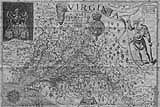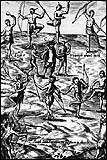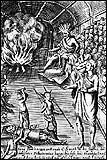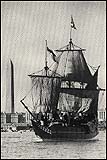.gif)
.gif)
John Smith (1579-1631)
 |
 |

|

|
|
John Smith's |
John Smith |
Pocahontas saving |
The Godspeed |
Captain John Smith has become a mythic hero in American history, largely because of the myths he himself created. Smith promoted the Virginia Company's interests in the New World and he provided the leadership necessary to save the colonists during the early years of the settlement. Although many of his narratives seem boastful and swashbuckling, his accounts were intended to lure adventurous new settlers to Virginia. Smith's descriptions of the settlement of Jamestown and his encounters with the Indians of the region are invaluable resources of American history.
John Smith was baptized in Willoughby by Alford, England, on January 9, 1579. He was the eldest son of George Smith and Alice Rickards. George Smith was a yeoman farmer who most probably worked for Peregrine Bertie (Lord Willoughby). Smith was educated in Alford and later he attended a boarding school in nearby Louth. He also served briefly as an apprentice to Thomas Sewell, a local merchant, but his formal education ended in 1596 when his father died. Smith's mother remarried soon after the death of her husband.
Although Smith inherited land from his father, he opted for a more adventurous life abroad. In 1596 or 1597 he joined a group of English volunteers and for the next four years he fought for Dutch independence from the Spanish King Phillip II. Smith returned to England briefly in 1599 and then set off again to France and Italy. He toured the Mediterranean on board a merchant ship and joined the Austrian forces in their battles against the Turks. One notable incident occurred in the battle against the Turks. Smith contends that he was captured by the Turks in Transylvania and was then transferred to Constantinople as a present for the Pasha's wife. She in turn fell in love with him and managed (with the help of her brother) to smuggle Smith to "safety." Evidently Smith wanted complete freedom, he killed the brother and returned to Transylvania. Smith continued his wanderings, eventually returning to England in 1604.
In England Smith soon developed an interest in the plans to colonize the New World. The Virginia Company received its charter from King James I on April 10, 1606. In December of the same year, three ships set sail for Virginia; Smith was one of the 144 colonists on board. The colonists landed at Jamestown on May 13, 1607 and James Smith served as one of the seven councilors of the colony.
The early years of the Jamestown settlement were marked by great hardship. The colonists suffered from disease, malnutrition, and frequent Indian attacks. Within the first seven months two-thirds of the colonists died. Smith stepped forward as the leader of the colony when it became apparent that the council of seven was ineffective. He led expeditions into the interior and traded with the Indians for corn. Smith and several other colonists were captured by Indians. In December 1607, Smith and several other colonists left the fort to explore the local area. Unfortunately they ran into an Indian hunting party and were promptly captured by the Indians. Although the other Englishmen were killed outright, the Indians took Smith to Chief Powhatan. According to his account in the General Historie, the Indians conducted a "trial" in which Smith was condemned to death. Smith claims that his life was spared due to the intervention of Powhatan's eleven-year-old daughter, Pocahontas. An alternate version suggests that Powhatan planned the capture and rescue for his own purposes.
Smith was not well received in Jamestown. Captain Christopher Newport and Gabriel Archer had assumed leadership during Smith's absence and the colonists still suffered from a lack of food and proper shelter. Smith soon escaped from the tension of the fort and proceeded to explore the Potomac and Rappahannock rivers and the Chesapeake Bay during the summer of 1608. His explorations of Virginia were later compiled in his Map of Virginia. Captain Newport returned to England in the fall of 1608 and John Smith was elected to the council once again in September.
Smith proved to be an able and efficient administrator and he quickly emerged as the leader of the settlement. He pressured Powhatan to provide corn for the colonists and he threatened to banish any colonist who was unwilling to work. Smith's discipline helped to sustain the colony through the winter of 1608-1609. However, Smith's prominent role in the colony was short-lived; Captain Newport returned to Jamestown in 1609, bringing new settlers and supplies and armed with a new charter for the Virginia Company. A power struggle ensued and Smith eventually lost his position as the president of the colony. Smith also injured himself in a gunpowder explosion in the fall of the year. He went back to England in October, 1609 and never returned to Virginia.
Smith did not abandon his commitment to the success of the Virginia settlement. Instead, he continued his efforts to promote Jamestown (if not the Virginia Company) in England, producing numerous narratives and maps of the new colony. In 1614 Smith, backed by London merchants, sailed to New England and returned to England with furs and fish. Smith published A Description of New England in 1616. He attempted a return trip to New England but was unsuccessful. During his remaining years in England, he published eight books. His more significant title is The General History of Virginia, the Somer Iles, and New England, with the Names of the Adventurers, and Their Adventures... Captain John Smith died in London on June 21, 1631. He is buried in St. Sepulchre's Church in London.
Bibliography
Barbour, Philip. The Three Worlds of Captain John Smith.
Boston:
Houghton Mifflin Company, 1964.
Jameson, J. Franklin. Narratives of Early Virginia. New
York:
Charles Scribner's Sons, 1907.
Kupperman, Karen Ordahl. Captain John Smith. Chapel
Hill:
University of North Carolina Press, 1988.
Morgan, Edmund S. American Slavery, American Freedom. New
York:
W. W. Norton & Company, 1975.
Smith, John. The Complete Works of Captain John
Smith.
Edited by Philip Barbour. Chapel Hill:
University of North Carolina Press, 1986.
Vaughan, Alden T. American Genesis: Captain John
Smith
and the Founding of Virginia. Boston:
Little, Brown and Company, 1975.
|
©Crandall Shifflett |